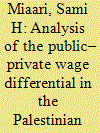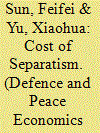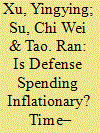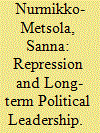|
|
|
Sort Order |
|
|
|
Items / Page
|
|
|
|
|
|
|
| Srl | Item |
| 1 |
ID:
171074


|
|
|
|
|
| Summary/Abstract |
This paper measures and analyzes the dynamics of the public–private wage differential in the West Bank and Gaza for the period before and during the ‘second Intifada’ using data from the Palestinian Labour Force Survey (PLFS) of the Palestinian Central Bureau of Statistics (PCBS). Because the distribution of workers’ individual characteristics, such as skills, and the ‘returns’ to these characteristics may differ across workers, the wage differential is decomposed into two components: an ‘endowment’ effect and a ‘returns’ effect. The results show that in the pre-Intifada period, the wage gap between the public and private sectors narrowed in both the West Bank and Gaza. However, a sharp increase is seen after the outbreak of the Intifada. Moreover, most of this increase comes from an increase in ‘returns’ to skills composition in the public sector, (unexplained effect), rather than a change in the skills composition of public sector workers, (explained effect). Using recent econometric quantile regression techniques, the analysis of the public–private sector wage gap from 1998 to 2006, at various points along the wage distribution, shows that the wage premium, (penalty), for the public sector varies across the distribution, being higher, (lower), at the lowest end of the wage distribution and decreasing (increasing) along the wage distribution; it becomes negative in the top percentiles.
|
|
|
|
|
|
|
|
|
|
|
|
|
|
|
|
| 2 |
ID:
171064


|
|
|
|
|
| Summary/Abstract |
The separatism and its related activities bring enormous economic costs to a society, which is however difficult to be estimated, because it involves both observable ethnic conflicts and unobservable psychological resistance. This paper investigates the economic consequences of the 1987–89 Tibetan Unrests with the synthetic control method and finds that per capita GDP in Tibet might be 27% higher for the period from 1988 to 2007 if the unrests had not happened. In addition, we implement several ‘placebo studies’ and assess the threats to the validity of causal inference to confirm the robustness of this study.
|
|
|
|
|
|
|
|
|
|
|
|
|
|
|
|
| 3 |
ID:
171075


|
|
|
|
|
| Summary/Abstract |
This study examines the nexus between the defense spending growth rate and inflation to test whether defense spending is inflationary in China, particularly in times of peace. Using wavelet analysis, we find that the linkage between the defense spending growth rate and inflation changes over time and across frequencies. We provide evidence supporting negative leading effects of inflation on the defense spending growth rate in certain periods across various frequencies. The results illustrate that the relationship is stronger at the short- to medium-term horizon of less than eight years than it is in the long term. No positive leading effect of defense spending on inflation is demonstrated, showing that defense spending is not inflationary in China. The results indicate that inflation lowers the defense spending growth rate at short and medium scales, particularly in peace time. This study provides new insights into the nexus between defense spending and inflation and emphasizes that such a correlation has time and frequency features. Meanwhile, given that there is little evidence supporting the idea that defense spending is inflationary, a moderate increase in defense spending will not damage price stability in China.
|
|
|
|
|
|
|
|
|
|
|
|
|
|
|
|
| 4 |
ID:
171065


|
|
|
|
|
| Summary/Abstract |
This paper develops a model where an incumbent may try to bribe the security forces to repress the political opposition in order to improve his/her chances of winning the elections. Such situations can be demonstrated by the cases of Cambodia, Uganda and Zimbabwe where the political leadership has used repression in and around the election times. In a collusive equilibrium, the security forces produce violence and the leader responds by giving a bribe to the former, this pair of actions taking place in each period. A collusive equilibrium exists when the bribe that a leader is prepared to pay is at least as large as the bribe that the security forces are willing to accept. We find that a harsher expected punishment (e.g. a longer prison sentence) will improve an incumbent’s incentives to collude. In contrast, security forces expecting a harsher punishment will be less likely to repress. Furthermore, we discuss the circumstances under which windfall revenue (e.g. foreign aid, resource rents) may contribute to violence and when it may prevent it.
|
|
|
|
|
|
|
|
|
|
|
|
|
|
|
|
| 5 |
ID:
171045


|
|
|
|
|
| Summary/Abstract |
This paper introduces model uncertainty into the empirical study of the determinants of terrorism at country level. This is done by adopting a Bayesian model averaging approach and accounting for the over-dispersed count data nature of terrorist attacks. Both a broad measure of terrorism and incidents per capita have been analyzed. Our results suggest that, among the set of regressors considered, those reflecting labor market conditions and economic prospects tend to receive high posterior inclusion probabilities. These findings are robust to changes in the model specification and sample composition and are not meaningfully affected by the generalized linear regression model applied. Evidence of a geographically heterogeneous relationship between terrorism and its determinants is also provided.
|
|
|
|
|
|
|
|
|
|
|
|
|
|
|
|
| 6 |
ID:
171044


|
|
|
|
|
| Summary/Abstract |
Over the last three decades, we have widely witnessed the peculiar relationship between tourism and incidents of political instability. Responding to the urgent call for additional empirical inquiries, we conducted an econometric study, using the VAR-EGARCH-DCC model, on the regional tourism interdependency (volatility) between four Eastern Mediterranean countries, namely Greece, Turkey, Cyprus and Israel. Monthly arrival data from 1987 to 2012, along with a series of political instability variables collected from machine-coded databases, were utilized to model effects and to add empirical substance to contemporary and emerging theories. Our findings are relevant to industry stakeholders in that they explore tourism demand and volatilities. The findings indicate a positive effect on tourism demand in the presence of verbal or material cooperation between a destination country and others. In contrast, when investigating verbal conflict between a destination country and others, our findings reveal a negative impact on tourist arrivals and an increase in volatility in the destination country. Finally, in our investigation of incidents of material conflict, we saw a strong negative impact on tourist arrivals in all four destinations, accompanied by a significant increase in volatility.
|
|
|
|
|
|
|
|
|
|
|
|
|
|
|
|
|
|
|
|
|